Midland County is in many ways a trip back in time to an older Texas, while also showing connections to the future. Built on oil for decades, Midland County boasts some of the highest salaries in Texas. While money can flow as freely as crude, Midland County is also connected to oil in a boom-bust cycle that seemingly has always been. Midland County has gotten a reputation for being an expensive county, though this seems to be more about perception when compared to the surrounding area. The Midland Central Appraisal District (CAD) is in charge of assessing, collecting, and distributing property taxes.
Midland County Homes Increase in Value
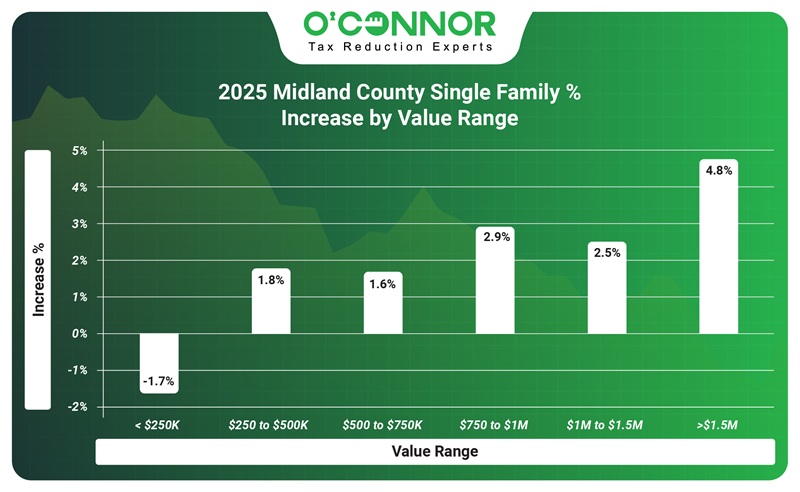
Midland County single-family homes saw their appraised value increase by 1.3% in 2025, compared to substantially higher gains in 2024 that saw homes increase by 7% on average. The myth of Midland pricing out middle and working-class people seems to be partially dispelled, as the appraised value for homes under $250,000 fell by 1.7%. The largest block of residential properties, those valued at $250,000-$500,000 increased by 1.8%. While luxury homes across Texas have generally seen their values increase by at least double digits in 2025, the value of homes worth over $1.5 million only edged up by 4.8%. Midland CAD tallied the value of all homes at a combined $16.48 billion.

Midland CAD looks to have been restrained in handing out large values in 2025. When broken down by the size of single-family homes, we can see how 1.3% is distributed. Homes between 2,000 and 3,300 square feet were the most common and added 1.3% to their value. Homes under 2,000 square feet are the second largest group of homes and grew slightly at 1.1%. The most notable statistic is that the largest of homes lost some value, with 1.7% for residences above 8,000 square feet.
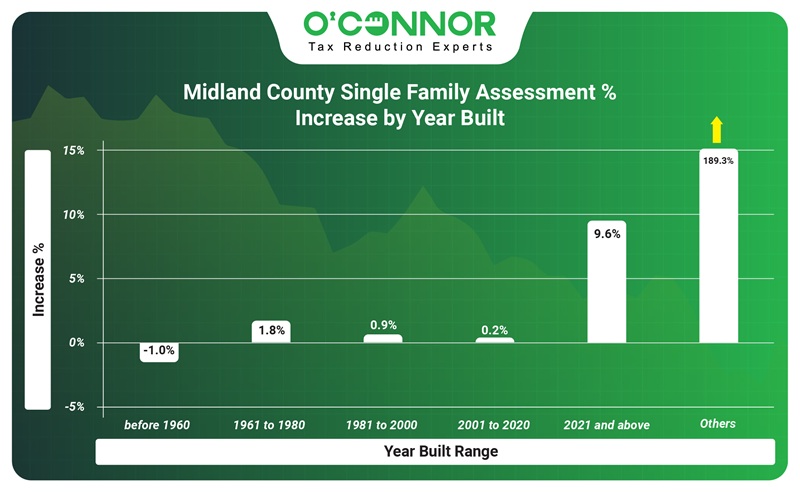
Like most Texas counties, Midland’s largest value in housing was built between 1981-2020. Homes built between 1981-2000 make up 23% of the property value, while those from the housing boom of 2001-2020 contribute 36%. Midland County has not seen the building bonanza that some trendy counties have done since 2021, but 8% of all value is still new construction. Recent construction saw a value increase of 9.6%, while older homes lost value by 1%. Possibly an outlier, but homes in the other category grew 189.35%. Everything between the oldest and newest houses grew at marginal rates, around that of inflation.
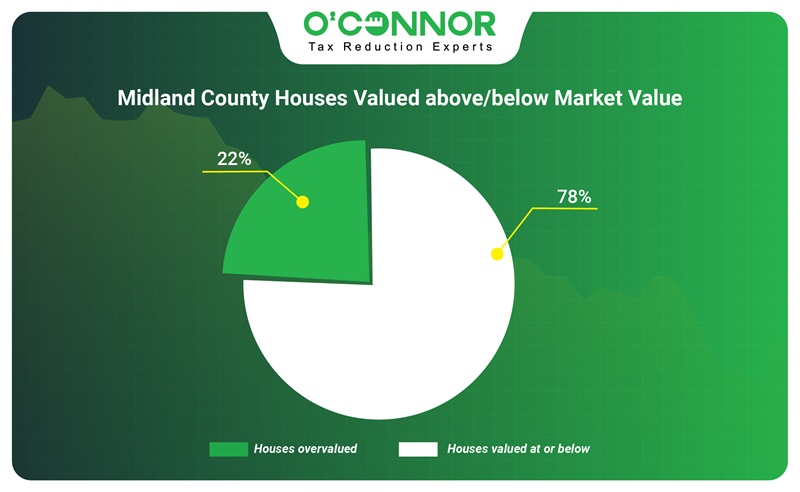
Midland CAD has perhaps made some changes for the better. In 2024, the appraisal district stated that their research showed that around 43% of all single-family homes were overvalued, taxing families more than their homes were worth. The appraisal district was able to cut that number down to 22% in 2025. This still leaves a lot of wiggle room for tax appeals to explore, as the true number probably sits somewhere between those two benchmarks.
Midland Undervalued?
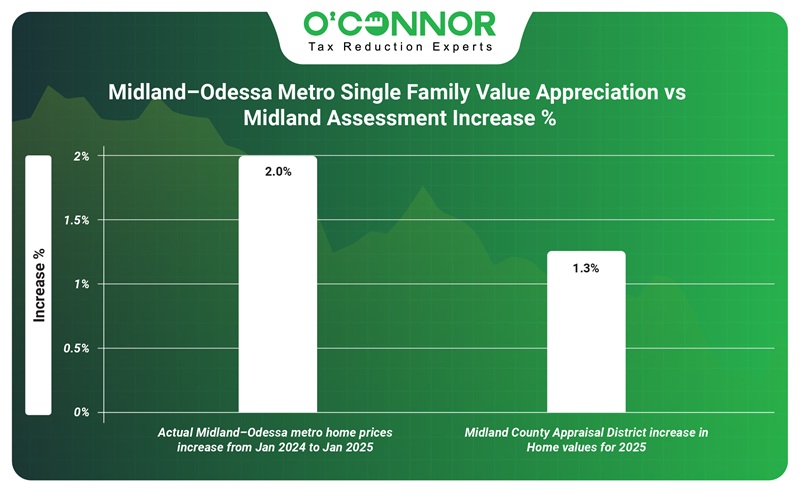
In a true Texas oddity, some research indicates that homes in Midland County are actually assessed below their true market value. Navica MLS, a company built for realtors and to gather property data, actually puts the growth of home prices at 2%, opposed to the 1.3% put forward by Midland CAD. This is actually very good news for Midland County homeowners. Even if it is a small margin, it shows that they are not getting fleeced with inflated taxes and that they could be getting a fair deal on their homes.
Midland Commercial Property is More Than Oil

The production of oil and natural gas is not included in the tabulation of commercial property values, or the numbers would be $30 billion higher or more. Still, Midland County has a strong business base, worth around $2.710 billion according to Midland CAD. There was a strong general growth of 7.3% seen in 2025, most of it coming from businesses worth between $1 million and $5 million. The highest percentage of added value, if not the highest in hard numbers, was for businesses worth $500,000 to $1 million. Big businesses added 6.1% in value, or $44.39 billion.
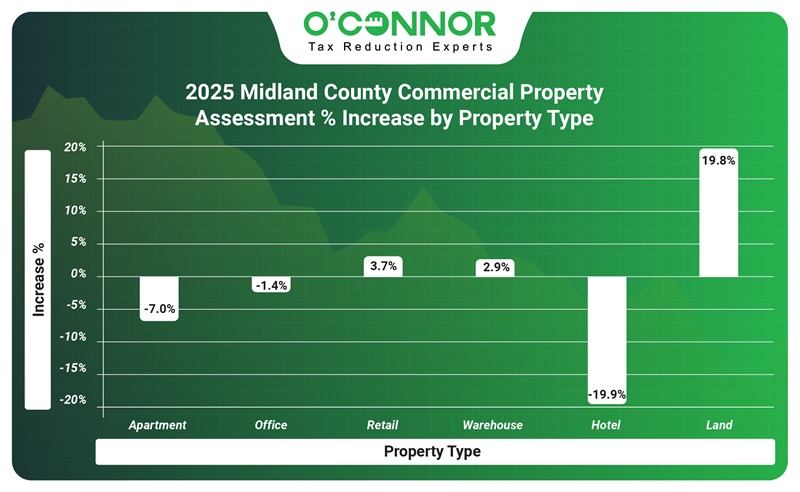
Midland County again shows its unique flair when we look at how commercial value is distributed. In many big counties, apartments make up the No. 1 spot for commercial properties. In Midland, they are near the bottom, only larger than retail businesses. Land is the biggest resource in Midland County, outside of oil, and it showed in 2025. Land not only valued $1.12 billion but added 19.8% to its value. Offices saw a loss of 1.4%, but still managed to stick in second place, just ahead of warehouses. The biggest loser was hotels, which saw a drop of 19.9%.

When Midland County’s commercial value is looked at in terms of age of construction, there are two things that stand out. One is that the dominance of land can be seen clearly, as 43% of all value in the county comes from it. Second, the majority of commercial property in the county was built during the boom of 2001-2020. Commercial property built before 2001 only values 10% of the total combined. New construction has already eclipsed these older buildings and is on the upswing, garnering a growth rate of 18.5%.
Midland Commercial Overinflated?
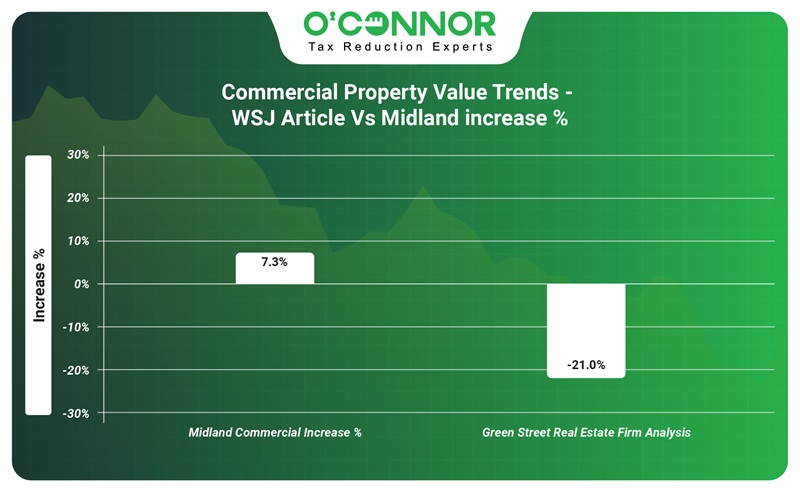
When we again return to outside research, we see an inverse to that of residential property. While it is believed that homes might be valued slightly lower than real market value, a new study shows that commercial property may be overvalued a great deal by Midland CAD. Analysis by the Green Street Real Estate Firm shows that commercial property is worth 21% less than it is assessed for. This is a nationwide study, so it might not reflect the reality in Midland County. Still, with the moderate growth in some businesses and the regression of others, it can certainly give a taxpayer pause. This is another sign that a commercial property owner should explore tax protests.
Midland Apartments Tell Tale of Modernization
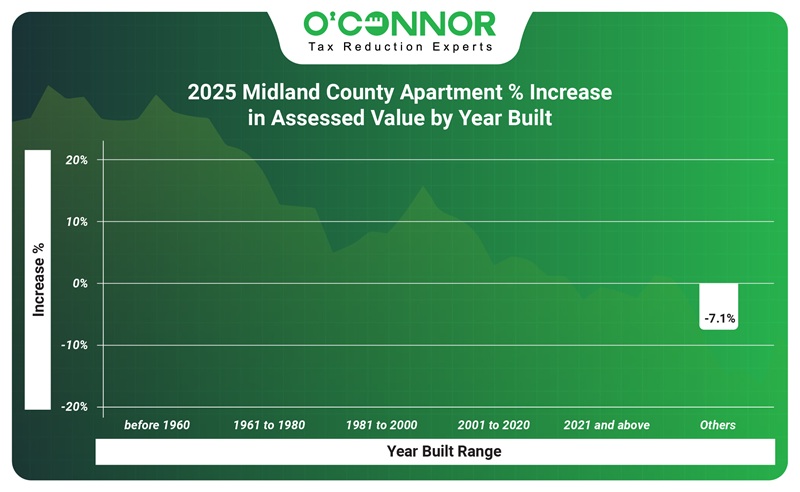
One reason that apartments account for so little value in Midland County’s commercial total is because they are a recent phenomenon. Harris, Dallas, and Travis Counties have all long been home to apartments of all stripes. Not so for Midland and the surrounding towns. When we look at the value of apartments by age, we see that 99% of apartment value was built after 1981. The lack of older apartments to build upon means that Midland County does not have a base of inherited value. Apartments lost 7% of total value in 2025.
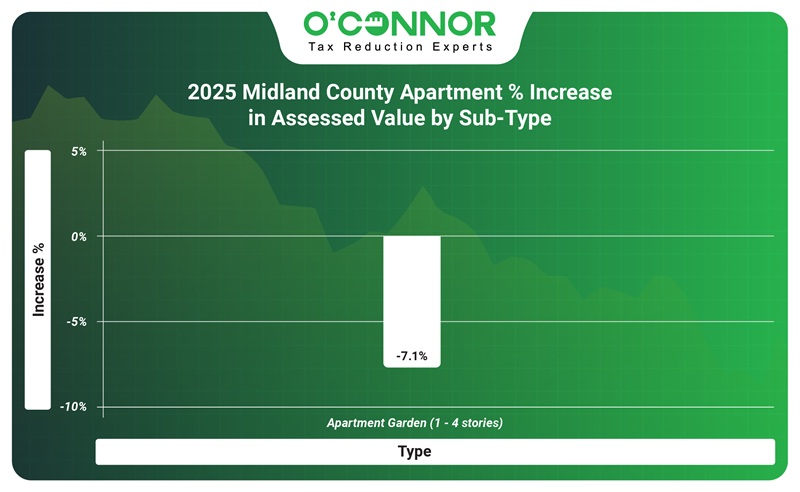
Due to their rather small footprint, apartments are not broken into many types by Midland CAD like they are in other counties. Garden apartments account for $43.39 million, while all other types total up to $511,000. This is not an uncommon set-up to see in a county that has a long history of being spread out and rural.
Midland Apartments Tell Tale of Modernization
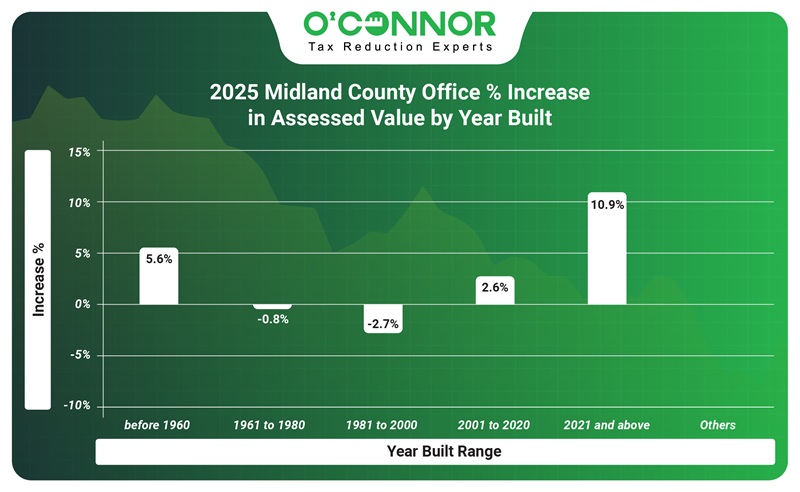
While offices have been hit hard by the pandemic in most other counties, Midland County’s commercial value is still strongly tied to them. With an estimated appraised value of $743.93 million, office space is only behind land in value. As we saw with general commercial property information, most of these offices were built during the 2001-2020 boom period. 66% of total office value was built during that timeframe. While office space lost 1.4% in combined value, there was a 16.9% gain for buildings constructed in 2021 or later. This is a good indicator of economic growth, with recent construction already accounting for 5% of all office value.
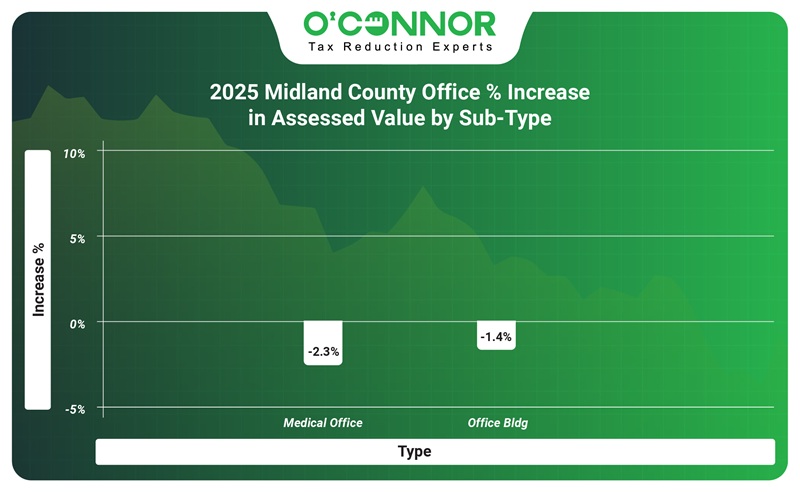
Much like apartments, Midland CAD does not break down office space into many types. Instead, they use generic office buildings or medical offices. Medical offices only account for $1.07 million in value, while the remainder is lumped together as office buildings. Both types saw small losses in value, with medical offices getting the shorter end of the stick with a decrease of 2.3%.
Midland Retail is Growing
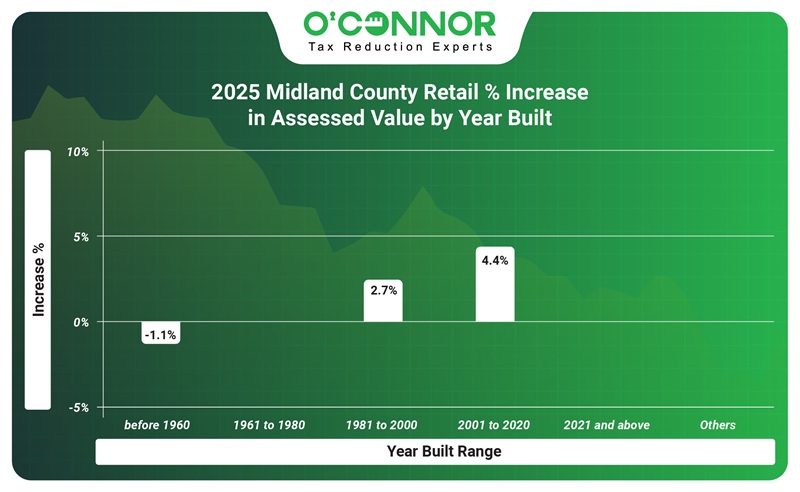
Despite economic and cultural shifts, Midland County is seeing steady growth in value for retail properties. Though retail only totals $32.14 million, it is showing consistent growth. 61% of all retail property was built between 2001-2020, which added 4.4% more value in 2025. 38% of retail buildings were built between 1981 and 2000. Again, it is easy to see the growth of Midland and other cities by observing the timeline of construction.
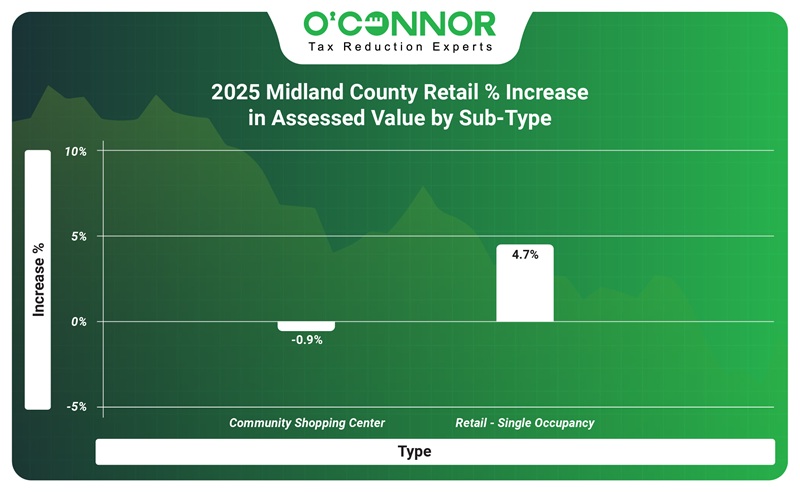
Midland CAD is again stingy with their classification of retail spaces. Single-occupancy retail buildings were in the clear No. 1 spot with $26.90 million in value assessed in 2025. Community shopping centers came in with only $5.24 million, even managing to lose .9% of value. Big box stores, on the other hand, were able to score a solid 4.7% increase.
Warehouses Remain Dependable
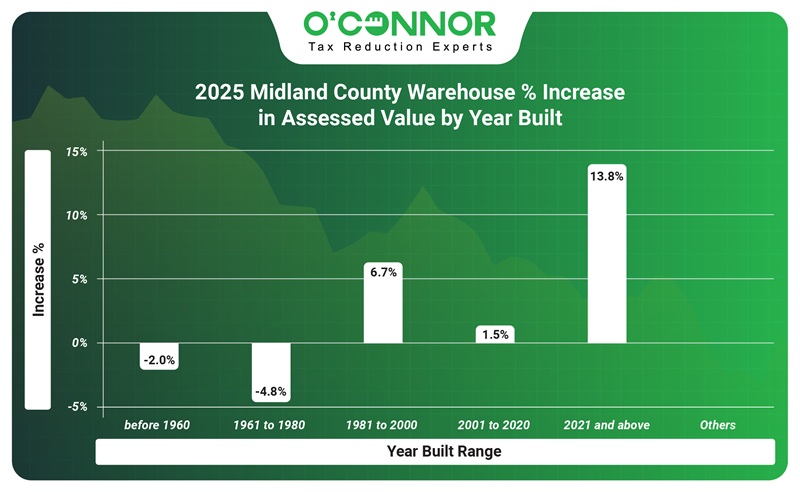
Befitting a county built around oil, Midland County has always been a warehouse hotbed. Totaling $734.04 million in value, warehouses were just behind offices for the No. 2 spot in the commercial total. Like every other building type in the county, most warehouses were built between 2001-2020. In this case, a whopping 82% of value was built during the pinnacle of construction. Warehouses are looking to continue their dominance into the next decade, as 13% of all value is from new construction. The value of recent construction also gained 13.8% in 2025.
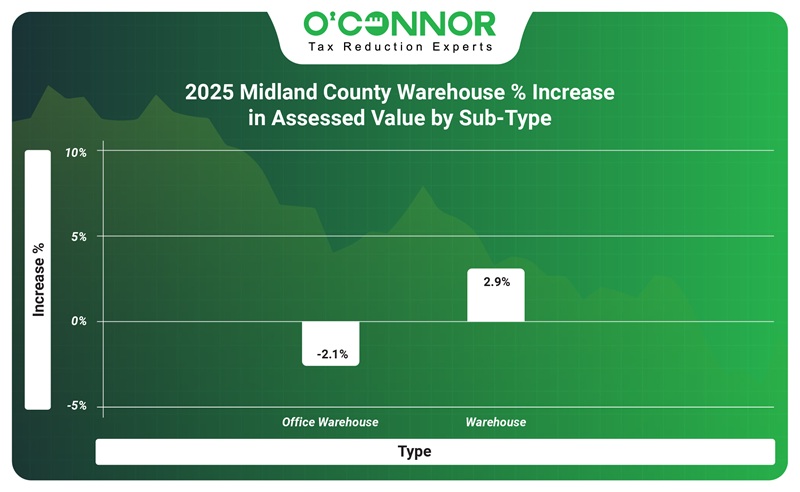
While Midland CAD fails to deliver on specifics yet again, at least one warehouse can be qualified. The office warehouse makes up only $1.30 million of the total, managing to lose 2.1% of value in 2025. All other warehouses continued to climb with 2.9% growth.
Midland Conclusions
Often hyped as an expensive community that is pushing out common people, the reality is that Midland County is doing well but certainly is not an exclusive area. You do not see the runaway property values of Collin, Travis, or Denton Counties. Nor do you see a backbreaking collapse in commercial or home values. Instead, Midland County is an oil boom area that is holding up well in changing times. In many ways, it is the same ole Midland, just modernized for the new decade.
It is hard to talk too much about Midland County without an in-depth look at the oil industry. Generating tens of billions of dollars, oil and gas drives everything in the county and surrounding area. Property values will naturally wax and wane around the success of oil and gas. Thankfully, things are currently going well in that respect, and Midland County seems to be growing a diverse economy to dovetail off of oil production.
Whether it is a lot of oil money at stake, or it is protecting your family home, the only way to stop inaccurate or overzealous taxation is to protest your property taxes. This is a right enshrined in the Texas Constitution and is one that the people of Midland County need to utilize. Founded in Houston, O’Connor has been in the business of fighting property taxes for 50 years. We know residential property like the back of our hands, and we have protested every type and size of oil and gas property. We are always free to join, and you will only pay if we lower your taxes.

